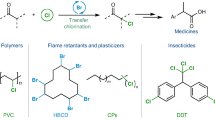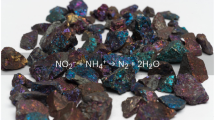Abstract
Decontamination of hazardous wastes containing dioxins (dibenzo-p-dioxin and its chlorinated analogues) remains a serious problem and new approaches for the degradation or alteration of dioxins are needed. We describe here dibenzo-p-dioxin radical cation formation and polymerization on a simple clay mineral (Cu(II)-smectite) in mild reaction conditions. Existence of the radical species was conclusively demonstrated using electron spin resonance (ESR), ultraviolet-visible, and infrared spectroscopy. The radical cation polymerized to form dimers and trimers as revealed by mass spectroscopy. Radical cations of 1- and 2-chlorodibenzo-p-dioxin were also formed on Cu(II)-smectite. The radical cations are formed by electron transfer from the dioxins to Cu(II). The formation of dioxin radicals may provide the basis for new detoxification methods in which the reactive radical species is coupled to other molecules or degraded by subsequent reactions.
This is a preview of subscription content, access via your institution
Access options
Subscribe to this journal
Receive 51 print issues and online access
$199.00 per year
only $3.90 per issue
Buy this article
- Purchase on Springer Link
- Instant access to full article PDF
Prices may be subject to local taxes which are calculated during checkout
Similar content being viewed by others
References
Esposito, M. P., Tiernan, T. O. & Dryden, F. E. Dioxins, 257 (US Environmental Protection Agency, Cincinnati, (1980).
Ayres, D. C., Levy, D. P. & Creaser, C. S. in Chlorinated Dioxins and Dibenzofurans in the Total Environment Vol. 2 (eds Keith, L. H., Rappe, C. & Choudhary, G.) 37–45 (Butter-worth, London and Ann Arbor Science, Ann Arbor, 1985).
Exner, J. H. et al. in Chlorinated Dioxins and Dibenzofurans in the Total Environment II (eds Keith, L. H., Rappe, C. & Choudhary, G.) 47–56 (Butterworth-Ann Arbor Science).
Doner, H. E. & Mortland, M. M. Science 166, 1406–1407 (1969).
Mortland, M. M. & Pinnavaia, T. J. Nature Phys. Sci. 229, 75–77 (1971).
Pinnavaia, T. J. & Mortland, M. M. J. phys. Chem. 75, 3957–3962 (1971).
Rupert, J. P. J. phys. Chem. 77, 784–790 (1973).
Fenn, D., Mortland, M. M. & Pinnavaia, T. J. Clays Clay Miner. 21, 315–322 (1973).
Pinnavaia, T. J., Hall, P. L., Cady, S. S. & Mortland, M. M. J. phys. Chem. 78, 994–999 (1974).
Mortland, M. M. & Halloran, L. J. Proc. Soil Sci. Soc. Am. 40, 367–370 (1976).
Tomita, M. & Ueda, S. Chem. pharm. Bull. 12, 33–37 (1964).
Shine, H. J. & Piette, L. J. Am. chem. Soc. 84, 4798–4806 (1962).
Yang, G. C. & Pohland, A. E. in Chlorodioxins-Origin and Fate, (ed. Blair, E.) 33–43 (American Chemical Society, Washington DC, 1973).
Author information
Authors and Affiliations
Rights and permissions
About this article
Cite this article
Boyd, S., Mortland, M. Dioxin radical formation and polymerization on Cu(II)-smectite. Nature 316, 532–535 (1985). https://doi.org/10.1038/316532a0
Received:
Accepted:
Published:
Issue Date:
DOI: https://doi.org/10.1038/316532a0
This article is cited by
-
Catechol degradation on hematite/silica–gas interface as affected by gas composition and the formation of environmentally persistent free radicals
Scientific Reports (2016)
-
DFT calculations for the structure and properties of polychlorodibenzo-para-dioxine anion-radicals
Journal of Structural Chemistry (2005)
Comments
By submitting a comment you agree to abide by our Terms and Community Guidelines. If you find something abusive or that does not comply with our terms or guidelines please flag it as inappropriate.



